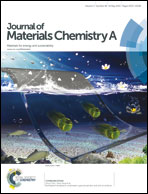A conductive interwoven bamboo carbon fiber membrane for Li–S batteries†
Abstract
Natural bamboo, as a sustainable precursor, is used to prepare porous bamboo carbon fibers (BCFs) that are subsequently interwoven into a BCF membrane (BCFM) as a captor interlayer for the lithium polysulfide intermediates between the sulfur cathode and the separator in Li–S batteries. On one hand, the interwoven BCFs offer efficient conductive networks. On the other hand, the pores of the BCFM facilitate fast mass transport of the electrolyte and Li ions and accommodate severe volume changes of the sulfur cathode during charge/discharge processes. Furthermore abundant macro/microporous structures of BCFs provide substantial adsorption capability to remarkably suppress the formation of the Li2S2/Li2S layer on the cathode and extend the lifetime of the electrode by successfully confining sulfur within the carbon networks. Consequently, Li–S batteries with the BCFM deliver excellent electrochemical performances with a high coulombic efficiency (ca. 98%), low capacity fade at only 0.11% per cycle, and long-term cyclability over 300 cycles at a high charge/discharge rate of 1 C. This green, low cost BCFM can provide an attractive alternative for large-scale commercialization of Li–S batteries.


 Please wait while we load your content...
Please wait while we load your content...